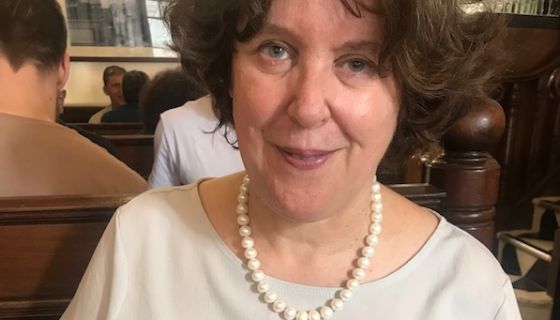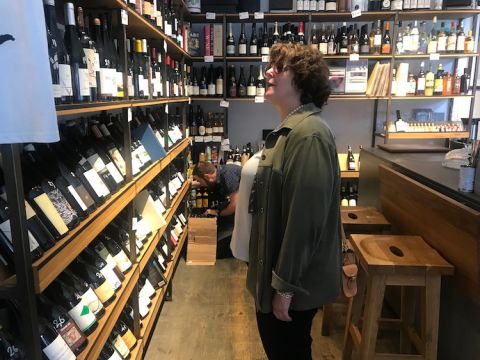I first sat down with Christine Parkinson in March 2011. Then, over dim sum cut into eight pieces and four white wines and four red wines, we tried all the eight chosen wines together with three sommeliers who then worked alongside her. At that time, and since 2001 just before the first Hakkasan opened, Parkinson fulfilled with great distinction the role of group wine buyer for this rapidly expanding group of Asian restaurants. There are now Hakkasans in New York, Las Vegas, San Francsico, Miami, Dubai, Abu Dhabi, Doha, Mumbai, Shanghai and Jakarta - all of which have benefited from Christine's input.
But on 15 September I received an email from Christine that said she and Hakkasan had parted company. This, I believed, provided the excuse for another lunch.
The venue this time was to be our son’s Quality Chop House in London EC1, not just because it fulfils one of my personal ambitions of ‘capital transfer’, but also because at £22 for two courses, it provides excellent value at lunchtime. The list of wines available by the glass is equally impressive.
No sooner had Christine sat down than her eyes lit up. ‘Whenever I see sprats on the menu I have to have them', she exclaimed. So after we had both ordered sprats, and she had ordered the onion tart with English feta and apple and I had ordered the Brixham brill with bagna cauda to follow, it was down to work.
Christine’s enthusiasm for alcoholic drinks is obvious in her new email address, chriswinesake@gmail.com and my first question was perhaps the easiest. How have customers’ wine preferences changed since you started buying, I wanted to know?
The most obvious change is of course in the percentage of New World wines that they are asking for, came the reply. There is also a growing trend towards less-dry white wines, which tend to work so well with Asian food, and of course there is the demand for far more orange and rosé wines. At the top end, demand for white burgundy, which she believes came from Asian customers eating out, has been replaced by an increase in demand for red burgundy from non-Asian diners. And, of course, there has been an enormous growth in demand for English sparkling wines.
Her response to my request that she choose a glass of white wine prompted a response that was both personal and professional. ‘I really enjoy Spanish whites at the moment. I find them very easy to live with', Christine explained, before choosing a couple of glasses of 2017 Louro Godello from Rafael Palacios for us. ‘And the restaurants now have to have available magnums of Albariño alongside the longstanding magnums of Chablis, Sancerre and New Zealand Sauvignon Blanc, to satisfy customer demand today.’
Her interest in sake emerged as gradually as the drink itself appeared in Hakkasan. ‘It appeared on the wine list only in 2010 when we opened Hakkasan Mayfair', she explained. ‘Until then it had been available only at the bar and they felt that they owned the drink.’
Her growing interest in this drink has been mirrored by the huge increase in that of the public. Until three or four years ago our sake classes on Saturday mornings were limited to older men or those who had spent some time in Japan. Today these same classes are filled with groups of 30-year-olds looking for something special to do with their Saturdays. From these I have even been asked to choose sake for various peoples’ weddings.’
Christine believes that this matching of a wine’s particular charms with what younger customers are looking for today holds the key for the success of the restaurant industry.
‘About five or six years ago restaurateurs got a terrific shock when they saw customers were drinking less and therefore spending less. This was the point at which the old system of wine ordering, where one person, invariably male, would be ordering wine from one wine list for the whole table started to disappear. This change frightened many restaurateurs who were too busy focusing on what their customers were not doing rather than on what they were doing.
‘This was the time when drinks flights and wine flights were taking off, when customers were becoming fascinated by cocktails, sake and spirits in general. What the customer was interested in was a diverse series of experiences of which wine was just one.’
When the time came for Christine to choose a glass of red she went immediately for the most unlikely wine on the list, a glass of Strekov 1075 Fred 2 made by winemaker Zsolt Sütő from Alibernet grapes in Slovakia. The list warned that this wine tasted of dark earth, an accurate tasting note it was to prove, for a wine that we both found fascinating.
Gus Gluck, host of Quality Wines, the autonomous wine bar next to The Quality Chop House (pictured above, with Christine scanning the shelves of the wine shop there), then came to say hello. He and Christine had developed a friendship from the Sommelier Wine Awards, the competition of which Christine has been the head judge for several years. This provided a nice segue into how she sees the development of sommeliers.
‘Basically, I see it in three stages. The first is all about the study of wine; sommeliers have an awful lot to learn and they are up for this. Then once they have absorbed all this learning, it is all about them, what can they add to the wines, what stories can they bring to the table. And finally, it is the jump to them appreciating that really it is all about the guest. I have found that it is quite easy to get from the first stage to the second but it is far more difficult for a sommelier to get from the second to the third. The best of them, such as Xavier Rousset, the late Gerard Basset and Enrico Bernardo, have all managed this final and very difficult transition.’ [See my recent article on this topic – What somms are for – JR.]
Over coffee I ask Christine whether she sees as many broad changes happening in the drinks world in the future as have happened to her since 2001? ‘Oh yes', came her immediate and enthusiastic response. ‘Wine lists will get smaller and incorporate numerous other drinks. Customer will talk to each other far more about what they are drinking. And although I hate the word ‘curate’, there will be far more scope for individuals to make their impression on what a wine list should be. I like what the founders of Trade, the private members club in Frith Street, Soho, have done where they have a small wine list and then a black book with all their gems hand written and then crossed out when they are sold. I see far more of this approach happening in the future.’
And as to Christine’s own future, I asked somewhat tentatively. It turned out that our lunch date had been well chosen as it coincided with her first day free from any work commitment to her former employer. ‘I’m feeling a bit demob happy', she explained, ‘which can be quite dangerous. I am going to enjoy myself and wait a few months before embarking on my next adventure.’














